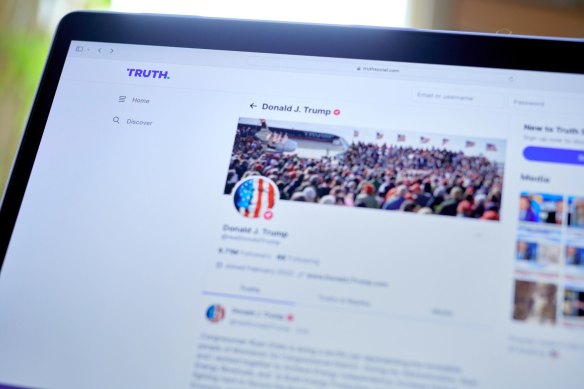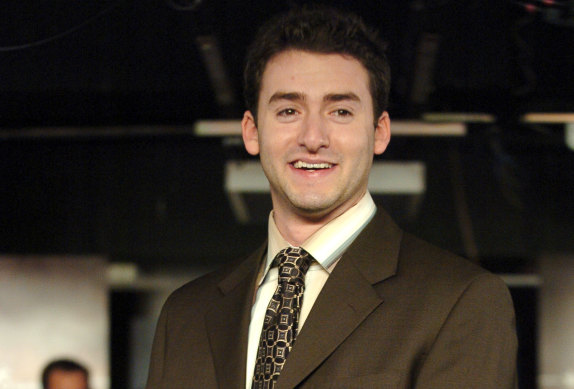
Trump’s prosperity is merely paper wealth. Trump Media’s share price is volatile, fuelled by amateur traders who often ignore business fundamentals. And Trump cannot sell his shares until September, under a provision common in merger agreements and public offerings, which restricts him and other large investors from immediately cashing in on shares. If he sells the stock, smaller shareholders may take it as a signal to flee.
“The risk of the Trump Media fortune is very, very high,” said Mike Stegemoller, a finance professor at Baylor University. “You’re now dealing with a fortune that is somewhat disconnected from reality.”
Representatives for Trump didn’t respond to requests for comment. Shannon Devine, a Trump Media spokesperson, said The New York Times’ reporting on the company was “filled with misleading insinuations and outright falsehoods, and supported by supposed experts who just happen to share the authors’ biases”.
Committed or not?
Trump Media was not Trump’s idea.
After Trump left the White House in 2021, two contestants from the second season of his reality TV show The Apprentice — Wes Moss and Andy Litinsky — pitched him an idea for a social media platform built around his brand.
Trump had just been barred from Twitter after the January 6 riot at the Capitol. Moss and Litinsky argued that if the former president built his own social media company, he wouldn’t be deplatformed again.

Truth Social has a small audience and generated $US770,000 in revenue in the first three months of the year while losing $US328 million.Credit: Bloomberg
In February 2021, Trump signed a deal with the duo to start Trump Media. He received a 90 per cent stake in the venture and the title of CEO. All he had to do was give it his name.
Moss and Litinsky oversaw the hiring of engineers to build Truth Social, which would largely cater to conservatives, with the aim of releasing the app in about a year.
But before the app was even built, Moss and Litinsky wanted to take Trump Media public through a merger with a “special purpose acquisition company.” SPACs are shell corporations that raise funds by offering shares on Wall Street, then look for private companies to combine with, allowing those companies to bypass the scrutiny that typically comes with an initial public offering.
Trump left the details to the Apprentice duo. Litinsky, a right-wing radio personality, cold-called hundreds of SPACs to strike a deal. It was “almost no different than picking up the phone to sell insurance,” he testified in federal court last month, in a legal case tied to the merger process.
He eventually found Patrick Orlando, an ex-Deutsche Bank trader who was working on setting up a SPAC called Digital World Acquisition Corp.
Moss and Litinsky brought Trump in for meetings to sign off on a merger. In February 2021, Orlando arrived at Mar-a-Lago to speak to the former president. Trump had been playing golf with Jack Nicklaus, the golfing champion, company records show.
Yet as negotiations unfolded, Trump considered abandoning Trump Media, according to a daily log of the company’s activities maintained by a former executive. He held talks with a rival startup called Gettr, a conservative social media platform led by a former campaign adviser, Jason Miller.
In September 2021, Litinsky and Moss persuaded Trump to sign a licensing deal committing him to Trump Media. Under the terms, Trump would have to post messages on Truth Social before publishing them on any other platform. Trump didn’t get additional money from the contract, but it included provisions allowing him to abandon his commitments if the merger took too long to close.

After Trump left the White House in 2021, two contestants from the second season of his reality TV show The Apprentice — Wes Moss and Andy Litinsky (pictured) — pitched him an idea for a social media platform built around his brand.Credit: Getty Images
A legal cloud
On the morning of October 20, 2021, the merger paperwork between Trump Media and Digital World was ready for a signing ceremony at Mar-a-Lago. Then Trump got a call.
On the other end was Miller, who ran Gettr. Miller again wanted Trump to join his app, Litinsky testified in April. Trump seemed undecided about what to do and summoned Litinsky to his Mar-a-Lago office, asking him to pitch the rationale for the merger with Digital World. Litinsky said he was worried the former president would abandon the deal.
Trump ultimately did not join Gettr. Later that day, he and Orlando signed the merger agreement during a meeting at Mar-a-Lago.
Trump Media’s next step was to release Truth Social, which officially debuted on February 21, 2022. “Because the president wanted a Ferrari, they built him a Ferrari,” Lori Heyer-Bednar, Trump Media’s chief legal officer, said at the time. But the site was initially plagued with glitches, prompting complaints.
Legal hurdles soon arose that delayed the regulatory approval for the merger. In late 2021, the SEC opened an investigation into the merger, while prosecutors prepared separate insider-trading charges against a group of early Digital World investors. (No one from Trump Media was charged with wrongdoing). Trump Media’s public debut couldn’t move forward until those legal issues were resolved.
With the deal hanging in the balance, Trump moved to strengthen his hold over Trump Media. In late 2021 and early 2022, he asked Litinsky to give company shares to his wife, Melania, according to court records and a person with knowledge of the matter.
Litinsky refused. In the spring of 2022, Trump had him ousted, according to a lawsuit Litinsky and Moss later filed against Trump Media. Moss left a few months later. They were replaced by Devin Nunes, a former Republican member of Congress, who became Trump Media’s CEO. Trump’s title changed to chair and Donald Trump Jr. joined the board.
But Trump Media was struggling to stay afloat. In regulatory filings, the company warned that it might go out of business if the merger wasn’t approved soon.
In July, Digital World agreed to pay $US18 million to the SEC to settle charges that it had misled investors about the deal with Trump Media. The settlement lifted a legal cloud. Trump received a new class of shares that gave him majority voting power over the company, and Trump Media recommitted to the merger.
On February 14, the SEC approved the merger agreement. The company’s path to the stock market was back on.
When the company started trading publicly on March 26, it surged 32 per cent over its first two days, closing around $US66.
After an infusion of new shares from the merger, Trump’s 90 per cent stake in Trump Media dropped to around 65 per cent. But he remains the single biggest shareholder with about 115 million shares — including 36 million that he received last month as a kind of bonus for the stock trading so well.
Loading
Trump also stepped back from being an officer or director of the company. He didn’t explain why, but Trump Media’s code of ethics says employees and directors engaging in “political activities are expected to do so as private citizens.”
In September, Trump can start selling Trump Media’s shares or use them as collateral for loans. If he sells on the open market, investors could take it as a negative sign and dump their stock, hurting the share price. To avoid that, Trump could try to negotiate a private sale, cashing in on some of his shares without causing a market panic.
“There would have to be a big discount,” Jagolinzer said. “The red flags are just so glaring.”
This article originally appeared in The New York Times.



























